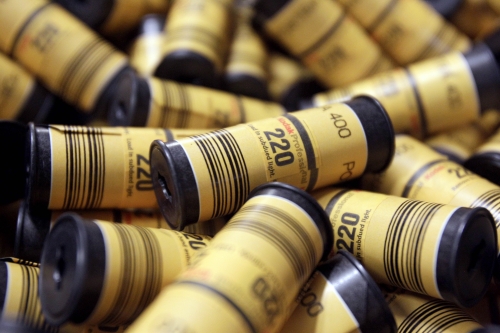Rochester, New York (AP) ― At Image City Photography Gallery, Gary Thompson delights in pointing out qualities of light, contrast and clarity in one of his best-selling prints ― a winter-sunset view of Yosemite National Park’s El Capitan peak shot with a hefty Pentax film camera he bought in 1999 for $1,700.
His wife, Phyllis, a latecomer to fine-art photography after they retired from teaching in the 1990s, favors a Hasselblad X-Pan for panoramic landscapes, such as a time-lapse shot of a harbor in Nova Scotia.
Of 11 partners and resident artists at the private gallery in Rochester ― the western New York city where George Eastman transformed photography from an arcane hobby into a mass commodity with his $1 Brownie in 1900 ― the Thompsons are the only ones left who haven’t switched to filmless digital cameras.

Kodak medium format film is loaded into a hopper for packaging in Rochester, New York, May 26. (AP-Yonhap News)
But that time may be near.
“I like the color we get in film, the natural light,” says Phyllis Thompson, 70, who married her high-school sweetheart 50 years ago. “But digital cameras are getting much better all the time, and there will come a time when we probably won’t be able to get film anymore. And then we’ll have to change.”
At the turn of the 21st century, American shutterbugs were buying close to a billion rolls of film per year. This year, they might buy a mere 20 million, plus 31 million single-use cameras ― the beach-resort staple vacationers turn to in a pinch, according to the Photo Marketing Association.
Eastman Kodak Co. marketed the world’s first flexible roll film in 1888. By 1999, more than 800 million rolls were sold in the United States alone. The next year marked the apex for combined U.S. sales of rolls of film (upward of 786 million) and single-use cameras (162 million).
Equally startling has been the plunge in film camera sales over the last decade. Domestic purchases have tumbled from 19.7 million cameras in 2000 to 280,000 in 2009 and might dip below 100,000 this year, says Yukihiko Matsumoto, the Jackson, Michigan-based association’s chief researcher.
For InfoTrends imaging analyst Ed Lee, film’s fade-out is moving sharply into focus: “If I extrapolate the trend for film sales and retirements of film cameras, it looks like film will be mostly gone in the U.S. by the end of the decade.”
Just who are the die-hards, holdouts and hangers-on?
Among those who still rely on film at least part of the time ― are advanced amateurs and a smattering of professionals who specialize in nature, travel, scientific, documentary, museum, fine art and forensic photography, market surveys show.
Regular point-and-shoot adherents who haven’t made the switch tend be poorer or older ― 55 and up.
But there’s also a swelling band of new devotees who grew up in the digital age and may have gotten hooked from spending a magical hour in the darkroom during a high school or college class.
Others are simply drawn to its strengths over digital and are even venturing into retro-photo careers.
“In everything from wedding to portrait to commercial photography, young professionals are finding digital so prevalent that they’re looking for a sense of differentiation,” says Kayce Baker, a marketing director at Fujifilm North America. “That artistic look is something their high-end clients want to see.”
Kodak remains the world’s biggest film manufacturer, with Japan’s Fuji right on its tail. But the consumer and professional films they make have dwindled to a precious few dozen film stocks in a handful of formats, becoming one more factor in the mammoth drop-off in film processing.
Scott’s Photo in Rochester finally switched this year stopped daily processing of color print film because fewer than one in 20 customers are dropping off film.





![[KH Explains] How should Korea adjust its trade defenses against Chinese EVs?](http://res.heraldm.com/phpwas/restmb_idxmake.php?idx=645&simg=/content/image/2024/04/15/20240415050562_0.jpg&u=20240415144419)
